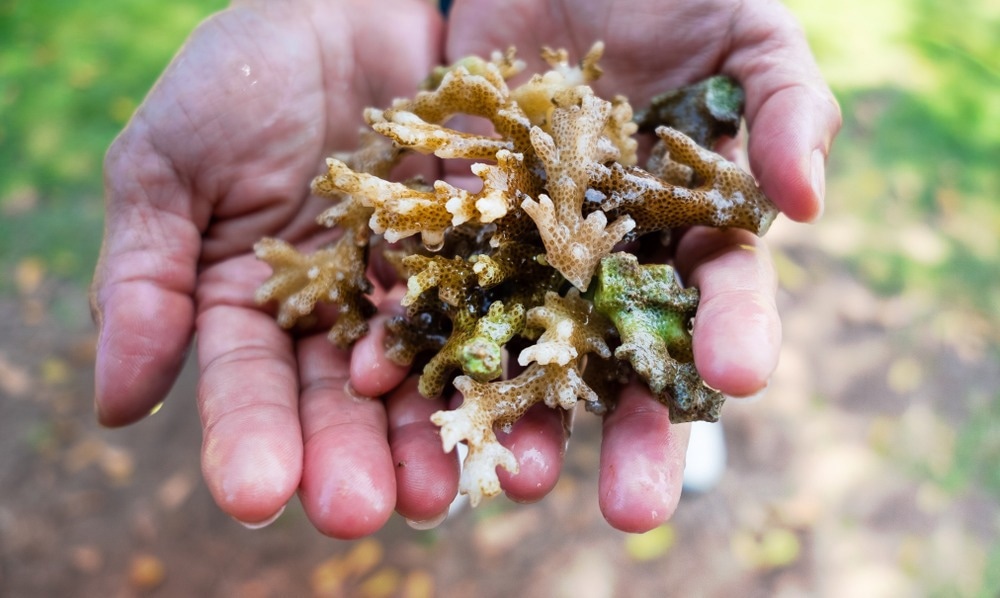In an article recently published in the journal Communications Earth & Environments, researchers examined the effects of ocean acidification (OA) on the recovery of coral holobionts after thermal stress events.

Image Credit: artapartment/Shutterstock.com
The study, conducted over two consecutive years, aimed to understand how feeding and simulated OA influenced the physiological recovery of coral species.
Understanding the impact of climate change on coral ecosystems, which are essential for marine biodiversity and coastal protection, is important.
Ocean Acidification and Coral Ecosystems
OA is a major environmental challenge caused by rising atmospheric carbon dioxide (CO₂) levels. When CO₂ is absorbed by seawater, it forms carbonic acid, decreasing the potential of hydrogen ion (pH) levels and negatively impacting marine life, particularly calcifying organisms like corals.
Coral reefs, built from the calcium carbonate skeletons of coral polyps, are susceptible to changes in pH and temperature. The symbiotic relationship between corals and zooxanthellae, photosynthetic algae, is crucial for coral health, providing energy and aiding in calcification.
The ongoing climate crisis has led to higher sea temperatures and more frequent marine heatwaves, causing widespread coral bleaching. During these events, coral expel their symbiotic algae, losing color and vital energy. Understanding the combined effects of OA and thermal stress is key to predicting coral resilience and survival in a changing ocean.
About the Research
In this paper, the authors aimed to understand how OA affects the recovery of two dominant Hawaiian coral species, including "Montipora capitata" and "Porites compressa". They comprehensively investigated whether exposure to acidified conditions would slow recovery from bleaching events caused by high temperatures.
To explore this, the researchers set up experimental tanks with different conditions: control (normal pH), fed (normal pH with zooplankton), OA (acidified seawater), and OA + Fed (acidified seawater with zooplankton). Coral samples were collected from Kāneʻohe Bay and Waimānalo Bay after major thermal stress events in 2014 and 2015.
Over several months, the study measured key physiological traits, such as endosymbiont cell density, calcification rates, tissue biomass, and total lipid content. Advanced statistical methods, including multivariate analysis of similarity (ANOSIM) and analysis of variance (ANOVA), were used to analyze the corals' physiological responses across the treatments and time points. The main hypotheses were that OA would delay recovery and that feeding could help offset its negative effects.
Key Findings and Their Significance
The outcomes showed that OA did not significantly affect the recovery of coral holobionts from thermal stress. Corals exposed to OA had similar physiological profiles to those in control conditions, suggesting that OA alone does not worsen the effects of thermal stress. This indicates that coral resilience may depend more on their ability to handle temperature fluctuations rather than changes in pH.
The study also emphasized the importance of heterotrophic feeding in boosting coral resilience. Corals that were fed showed better physiological responses, such as higher calcification rates and lipid reserves. This highlights potential management strategies to support coral recovery, including feeding programs during bleaching events.
Additionally, species-specific differences were noted, with Montipora capitata showing greater resilience than Porites compressa. These results are crucial for conservation efforts, suggesting that some coral species may be better suited to survive and recover from climate-related stress.
Applications for Coral Management and Conservation
This research has significant implications for coral reef management and conservation. Based on the findings, coral managers may consider implementing feeding programs during bleaching events to boost recovery rates, particularly in areas experiencing frequent thermal stress. This approach could help reduce the impact of climate change on coral health.
Additionally, understanding the resilience of specific coral species can guide restoration efforts. By focusing on more resilient species, conservation practitioners can prioritize efforts to enhance the survival and recovery of coral populations in vulnerable areas.
The authors contribute to a deeper understanding of how corals respond to climate change, offering valuable insights for predicting future reef dynamics under changing environmental conditions. As marine ecosystems face growing challenges, these studies are essential for developing effective conservation strategies.
Conclusion and Future Directions
In summary, this research conducted by Kerri L. Dobson et al. demonstrated that OA did not hinder the recovery of coral holobionts from thermal stress. Their findings highlighted the resilience of certain coral species in changing ocean conditions and underscored the benefits of heterotrophic feeding in improving coral recovery.
Future work should examine the long-term effects of repeated thermal stress and OA on various coral species. Investigating additional factors contributing to coral resilience is essential for developing effective conservation strategies. Understanding the relationship between environmental stressors and coral health remains crucial, as coral reef survival is critical for maintaining marine biodiversity and ecosystem services in the face of climate change.
Disclaimer: The views expressed here are those of the author expressed in their private capacity and do not necessarily represent the views of AZoM.com Limited T/A AZoNetwork the owner and operator of this website. This disclaimer forms part of the Terms and conditions of use of this website.
Source:
Dobson, K.L., Jury, C.P., Toonen, R.J. et al. Ocean acidification does not prolong recovery of coral holobionts from natural thermal stress in two consecutive years. Commun Earth Environ 5, 515 (2024). DOI: 10.1038/s43247-024-01672-5, https://www.nature.com/articles/s43247-024-01672-5